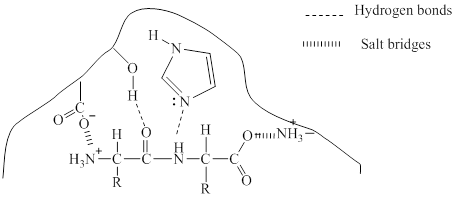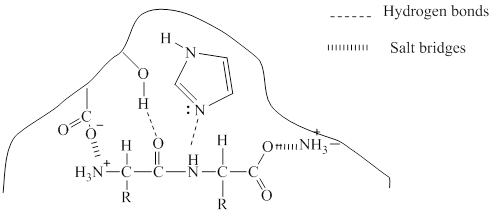
Interpretation:
The two types of bonding which will occur in the bonding of the enzyme-substrate complex should be given with dotted lines.
Concept Introduction:
Enzyme:
- It is a protein or a molecule which can act as a catalyst for a biological reaction.
- Does not affect the equilibrium point of the reaction.
- Active site of the enzyme is the region where the reaction takes place.
- Enzyme’s activity can be specific which means the activity is limited to a certain substrate and a certain type of reaction and it is referred to as specificity of the enzyme.
Hydrogen bonding: It is an unusual strong intermolecular force occurs between a hydrogen atom and an electronegative atom like nitrogen, oxygen or fluorine. It occurs in both water and ammonia
Answer to Problem 19.24UKC

Explanation of Solution
Enzymes are three dimensional molecule with a catalytic site into which the substrate can fit. The enzymes are said to be so specific in their action because the activity is limited to a certain substrate and a certain type of reaction and it is referred to as specificity of the enzyme. It can be said that few molecules have the appropriate shape and
Given in the diagram a dipeptidase enzyme and the substrate to form the enzyme-substrate complex. Different types of bonding may occur between the enzyme and the substrate to form the enzyme-substrate complex.
Hydrogen bonding is the attraction between a hydrogen atom and an electronegative atom and it can be considered as a special type of dipole-dipole interaction. The oxygen atom in the substrate can make hydrogen bond with hydrogen in the enzyme.
Salt bridges are formed between oppositely charged residues that are nearby to experience electrostatic attraction. Here, salt bridge is formed between the anionic carboxylate ion
The bonding is shown below:

The two types of bonding which will occur in the bonding of the enzyme-substrate complex is given with dotted lines.
Want to see more full solutions like this?
Chapter 19 Solutions
Fundamentals of General, Organic, and Biological Chemistry, Books a la Carte Plus Mastering Chemistry with Pearson eText -- Access Card Package (8th Edition)
- Background Freezing isn't the only challenge in cryopreservation - thawing can be just as difficult. A microwave oven seems like a nice solution, since it deposits energy quickly and microwaves are non-ionizing radiation (they do not cause DNA mutation). However, water absorbs microwaves more effectively than ice does, meaning that the portion of an organ that has already melted will get warmer at a higher rate than the remaining ice – the opposite of what we want! - The transmission of radiation through a weakly absorbing material such as ice or water can be modeled by Beer's law, which assumes that the rate of absorption at a depth x is proportional to the local radiation intensity I(x) times an absorption coefficient, which is often written as μ or a or just µ). Noting that absorption decreases the intensity, we can write a differential equation a Solving the differential equation with the boundary condition on the surface being gives the relationship For a standard microwave oven…arrow_forward3. Dry air is inhaled at a rate of 10 liter/min through a trachea with a diameter of 20 mm and a length of 125 mm. The inner surface of the trachea is at a normal body temperature of 37°C and may be assumed to be saturated with water. a. Assuming steady, fully developed flow in the trachea, estimate the mass transfer convection coefficient. b. Estimate the daily water loss (liter/day) associated with evaporation in the trachea.arrow_forward1. Conceptual questions a. What dimensionless group describes the relative importance of convection versus diffusion. Explain the physical basis of this group. b. For mass transfer from a flowing fluid to a reactive surface, explain how convection increases the flux of solute to the surface.arrow_forward
- Assessment +1501 pts /1600 Resources Solution ? Hint Sub bo Each pictured Lewis structure is invalid. Identify the error in each case. O Macmillan Learning :0▬▬0: Answer Bank wrong electron total :0- :F======F: octet-rule violation N :0:arrow_forward[s] mM V (M/s) Uninhibited 0.333 1.65 x 107 1.05 x 107 V (M/s) x 10' Inhibitor A V (M/s) x 107 Inhibitor B 0.794 x 107 0.40 1.86 x 107 1.21 x 107 0.893 x 107 0.50 2.13 x 107 1.43 x 107 1.02 x 107 0.666 2.49 x 107 1.74 x 107 1.19 x 107 1.0 2.99 x 107 2.22 x 107 1.43 x 107 2.0 3.72 x 107 3.08 x 107 1.79 x 107arrow_forwardFor a Michaelis-Menten reaction, k₁-5 x 10'/M-s, k.-2 x 10%/s, and k₂-4 x 10²/s. a) Calculate the Ks and KM for this reaction. b) Does substrate binding achieve equilibrium or steady state?arrow_forward
- Assume that an enzyme-catalyzed reaction follows the scheme shown: E+S SES →E + P k₁ = 1 x 109/M-s k-1=2.5 x 10%/s k₂ = 3.4 x 107/s What is the dissociation constant for the enzyme-substrate, K,? What is the Michaelis constant, Km, for this enzyme? What is the turnover number, Keat, for this enzyme? What is the catalytic efficiency for the enzyme? If the initial Et concentration is 0.25mM, what is Vmax?arrow_forwardAn enzyme lowers the activation energy, (AG) of a reaction from 50.0 kcal/mol to 40.0 kcal/mol. Calulate the catalytic power at 310K. (R-1.987x10 kcal/mol)arrow_forwardDraw a typical axodendritic synapse, including a specific neurotransmitter of your choice, its associated postsynaptic receptors (indicating whether they are ionotropic or metabotropic), and any associated reuptake transporters or degradation enzymes. Please include a description of what specific steps would occur as an action potential reaches the axonal terminal.arrow_forward
- Give a full arrow pushing mechanism of the spontaneous redox reaction between NAD+/NADH and oxaloacetate/malate. Please include diagram drawing of the mechanism! (Thank You!)arrow_forward18. Which one of the compounds below is the major organic product obtained from the following series of reactions? 1. BH3 2. H2O2, NaOH H₂CrO4 CH2N2 oro ororos A B C D Earrow_forward17. Which one of the compounds below is the major organic product obtained from the following series of reactions? CI benzyl alcohol OH PBr3 Mg 1. CO2 SOCl2 ? ether 2. H+, H₂O CI Cl HO OH CI Cl A B C D Earrow_forward
 Biology: The Dynamic Science (MindTap Course List)BiologyISBN:9781305389892Author:Peter J. Russell, Paul E. Hertz, Beverly McMillanPublisher:Cengage Learning
Biology: The Dynamic Science (MindTap Course List)BiologyISBN:9781305389892Author:Peter J. Russell, Paul E. Hertz, Beverly McMillanPublisher:Cengage Learning Biology (MindTap Course List)BiologyISBN:9781337392938Author:Eldra Solomon, Charles Martin, Diana W. Martin, Linda R. BergPublisher:Cengage Learning
Biology (MindTap Course List)BiologyISBN:9781337392938Author:Eldra Solomon, Charles Martin, Diana W. Martin, Linda R. BergPublisher:Cengage Learning Human Heredity: Principles and Issues (MindTap Co...BiologyISBN:9781305251052Author:Michael CummingsPublisher:Cengage Learning
Human Heredity: Principles and Issues (MindTap Co...BiologyISBN:9781305251052Author:Michael CummingsPublisher:Cengage Learning





